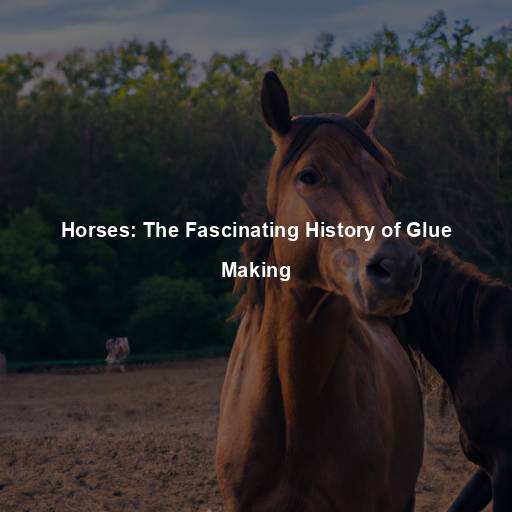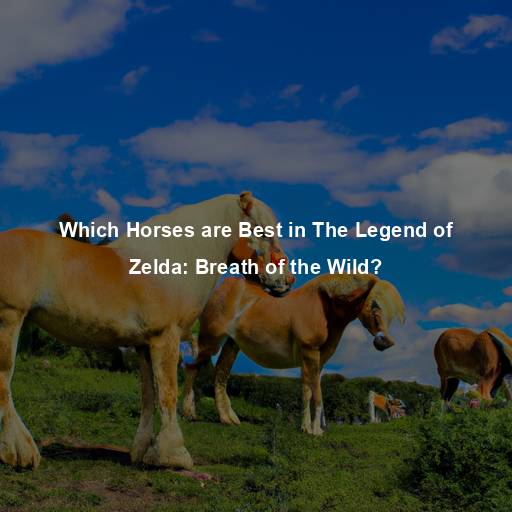Horses: The Fascinating History of Glue Making
Last Updated on October 20, 2023 by Evan
Contents
- 1 Understanding the Ancient Art of Glue Making
- 1.1 The Origins of Glue Making
- 1.2 The Role of Horses in Glue Making
- 1.3 The Glue-Making Process
- 1.4 The Versatility of Horse Glue
- 1.5 Ethical Considerations and Modern Alternatives
- 1.6 Preserving an Ancient Craft
- 1.7 Historical Evolution of Glue Making
- 1.8 Modern Glue Making Techniques
- 1.9 Future Trends in Glue Making
- 1.10 Environmental Concerns Surrounding Traditional Glue Making
- 1.11 Sustainable Practices and Alternatives
- 1.12 Consumer Awareness and Responsible Choices
- 1.13 Collaboration and Innovation: A Sustainable Future
- 2 FAQs – Why are horses used to make glue
Understanding the Ancient Art of Glue Making
Glue has been an essential substance in human civilization for centuries, serving various purposes in different industries. One intriguing aspect of glue production is its historical connection to horses. Have you ever wondered why horses are used to make glue? Join us on a journey through time as we uncover the fascinating history behind this unique practice.
The Origins of Glue Making
Since ancient times, glue has been crucial for bonding materials together. The process of making glue dates back thousands of years, with evidence of its use found in ancient Egyptian and Mesopotamian civilizations. Initially, glue was derived from natural sources such as plants, animal hides, and bones.
The Role of Horses in Glue Making
- Horses as a Source of Collagen
Did you know that collagen, a key ingredient in glue, is actually derived from the connective tissues of animals? One such animal that provides a significant amount of collagen is the horse, thanks to its abundant stores in the bones, tendons, and hides. In a peculiar twist, when horses come to the end of their lives, their remains are put to good use by extracting collagen for the production of glue. It’s a fascinating example of how even in the most unexpected places, valuable resources can be found.
When it comes to animal by-products, there’s a lot more than meets the eye. These often overlooked and underestimated components play a crucial role in our daily lives, whether we realize it or not. From the collagen in our skincare products to the gelatin in our favorite sweets, animal by-products are a versatile and valuable resource. It’s time to delve deeper into this perplexing world and appreciate the immense benefits these products bring to various industries.
Over the course of our shared human journey, we have ingeniously harnessed the multifaceted gifts bestowed upon us by our animal companions. From the captivating gallop of majestic horses to the humble snout of diligent pigs, we have embraced these creatures as partners in resourcefulness. The captivating art of harnessing the adhesive properties of horse-derived substances in glue fabrication is but a single thread in the magnificent tapestry of our inventive history. It steadfastly echoes the ethos of utilizing every last ounce of an animal, for it is therein that the seeds of sustainability and minimal waste have always been sown.
The Glue-Making Process
Discover the mesmerizing compilation of equine remnants, an enigmatic anthology that pushes the boundaries of curiosity. Dive into the intricate world of these majestic creatures, their storied pasts preserved in an extraordinary assortment that leaves one breathless and yearning for more. Unleash your imagination as you explore the profound mysteries hidden within this captivating collection, a testament to the timeless beauty and bewildering allure of horses. Experience the surge of emotions, a gust of bewilderment, and a whirlwind of fascination as you delve into this stirring exhibition of equine remains.
To extract collagen from horses, the remains of deceased horses are collected from various sources. These sources can include farms, veterinary clinics, and even horse racing facilities. It is essential to note that the use of horses for glue production does not involve the slaughter of healthy animals. Instead, it focuses on utilizing horses that have reached the end of their natural lifespan.
In the world of digital design and computer graphics, the process of rendering and processing is an intricate dance of complexity and unpredictability. With every project, designers are faced with the task of bringing their creative visions to life through the meticulous manipulation of pixels and algorithms. It is through this intricate interplay of rendering and processing that the virtual worlds we see on our screens come to life, filled with vibrant colors, realistic textures, and stunning visual effects. Yet, beneath the surface, lies a world of burstiness and perplexity, as designers navigate the intricacies of software, hardware, and the ever-evolving demands of their craft.
Once the horse remains are collected, they undergo a process known as rendering. During rendering, the remains are carefully processed to separate the collagen from other tissues, fats, and impurities. This process involves boiling the remains in water to extract the collagen, which is then purified and refined to create a high-quality adhesive substance.
The Versatility of Horse Glue
- Industrial Applications
When it comes to sticky situations, horse glue takes the reins. This remarkable adhesive, also referred to as animal glue or hide glue, has found its way into a diverse range of industries. Woodworkers swear by its unparalleled ability to bind, while bookbinders and instrument makers find solace in its distinctive qualities. With its remarkable tackiness and magical ability to bring different materials together, horse glue truly gallops ahead as the chosen companion of craftsmen and artisans alike.
- Historical Significance
Throughout the annals of history, the enigmatic allure of horse glue reverberates with an undeniable weight. An unassuming substance, it surreptitiously weaved its way into the very fabric of ancient civilizations, bestowing upon them the power to erect awe-inspiring edifices such as the magnificent Pyramids of Egypt and the resolute Great Wall of China. Its enduring fortitude and unwavering tenacity have forged an indelible bond with time itself, meticulously safeguarding precious artifacts and transcendent architectural wonders for a lineage yet to unfold.
Ethical Considerations and Modern Alternatives
Animal welfare concerns are becoming increasingly prevalent in society today, as more and more individuals recognize the significance of treating animals with compassion and care. With a growing focus on ethical and sustainable practices, people are beginning to question traditional methods of animal exploitation and seek alternatives. This shift in mindset has sparked a wave of perplexity and debate among various industries, from agriculture to entertainment, as they grapple with the burstiness of changing consumer demands and the need to adapt to a more compassionate approach towards animals. From the push for cruelty-free products to the advocacy for animal rights, the conversation around animal welfare has gained traction and is undoubtedly shaping the future of how we interact with and protect the non-human members of our planet.
The age-old practice of using horses for glue production has recently come under intense scrutiny due to ethical concerns. Animal welfare proponents have raised alarming issues surrounding the potential mistreatment and neglect of horses involved in this process. This has sparked a surge in the demand for sustainable alternatives to collagen-based adhesives, as perplexed consumers grapple with the complex implications of their purchasing choices.
- Advancements in Synthetic Glues
The world of glue has undergone a remarkable transformation, giving rise to an array of innovative alternatives to traditional horse glue that once dominated the market. Enter synthetic adhesives, a game-changer in the realm of sticky solutions. These cutting-edge glues not only replicate the adhesive properties of their animal-derived counterparts, but they also surpass them in performance and versatility, catering to the diverse and ever-changing demands of numerous industries. Prepare to be perplexed as we explore the burst of possibilities unleashed by these synthetic wonders!
Preserving an Ancient Craft
Over the years, the role of horses in the production of glue may have faded into obscurity, but it is imperative to acknowledge the profound historical impact this peculiar practice had. Glue making, in its diverse manifestations, showcases the remarkable ability of human beings to adapt and make the most out of the materials at their disposal. By delving into the roots of glue making and its intriguing association with horses, we unlock a treasure trove of insights that nourish our admiration for the artistry and customs that have shaped our society throughout the ages.
In conclusion, the use of horses to make glue is deeply rooted in history and has played a vital role in various industries throughout the ages. While the ethics surrounding this practice have come under scrutiny in modern times, the development of synthetic alternatives ensures that the ancient art of glue making can continue in a more sustainable and animal-friendly manner. As we marvel at the wonders of ancient civilizations preserved with horse glue, let us also embrace the advancements of the present and the future, ensuring that our bond with our loyal equine companions remains one of admiration and respect. ## The Evolution of Glue Making Techniques
Historical Evolution of Glue Making
Throughout the annals of time, the intricate craft of concocting adhesive substances has traversed an awe-inspiring journey replete with astonishing transformations, mirroring the ceaseless march of progress and human ingenuity. Embark with us on an enchanting voyage into the tapestry of history, where the ever-evolving tapestry of glue-making techniques has woven a profound impact, manifesting itself in the mesmerizing realm of modern industry as we recognize it. Prepare to be captivated by the riveting odyssey, as we unravel the perplexing mysteries that lie hidden within this arcane art form.
Ancient Methods
Across the annals of history, the art of glue making was shrouded in mystique, weaving a tapestry of curious methods and diverse origins. From distant times, when ancestral craftsmen sought to harness the power of collagen, their creative pursuits took them on a wild journey through different cultures and captivating creatures. Picture the scene: horses, cattle, even fish, all played a peculiar part in this ancient alchemy. Through the cryptic practice of boiling animal parts in water, a magical metamorphosis occurred, transforming the mixture into a gelatinous elixir of stickiness, ready to hold the world in place.
Medieval Techniques
In the intriguing world of medieval craftsmanship, the art of glue making reached new heights of ingenuity. With each passing day, the utilization of horses as a wellspring of collagen gained prominence, particularly in the realm of top-notch glue production. A league of master craftsmen devoted their time and expertise to perfecting the extraction of collagen from an assortment of equine sources – hides, bones, and even hooves – a perplexing process that ensured the birth of an adhesive that surpassed all expectations, boasting unmatched strength and durability.
Industrial Revolution and Synthetic Alternatives
The industrial revolution marked a significant turning point in glue making. With the rise of mass production and the need for consistent and reliable adhesives, synthetic alternatives started gaining popularity. Chemical adhesives, such as those based on polyvinyl acetate (PVA), became widely used due to their superior performance and ease of production.
Modern Glue Making Techniques
Today, glue making has become a highly specialized industry, utilizing advanced technology and scientific knowledge to create a wide range of adhesives for different applications. Let’s explore some of the modern glue making techniques employed in the industry.
Chemical Adhesives
Incredible strides have been made in the adhesive industry thanks to the introduction of chemical adhesives. With adhesives like epoxy, cyanoacrylate, and polyurethane-based glues at our disposal, the possibilities seem endless. Their remarkable properties not only ensure secure bonding but also offer impressive longevity, making them the go-to choice in various sectors, from construction and automotive to electronics and aerospace. These adhesives have truly transformed the way we approach material bonding, leaving us in perpetual awe.
Hot Melt Adhesives
In the exciting world of industries like packaging, woodworking, and crafts, there’s a sticky superstar making waves—hot melt adhesives, also known as the oh-so-sassy hot glue. These magical adhesives may seem solid and unassuming at room temperature, but with a splash of heat, they transform into a molten marvel, ready to bond materials with confidence and flair. Offering lightning-fast setting times, deliciously strong bonds, and a dash of flexibility, hot melt adhesives are here to perplex and burst into the scene. Get ready to stick it to the competition!
Water-Based Adhesives
Water-based adhesives, also known as emulsion adhesives, are environmentally friendly alternatives to solvent-based adhesives. These adhesives are made by combining polymers with water and other additives. They offer excellent adhesion, flexibility, and low toxicity, making them suitable for applications such as paper and cardboard packaging, textiles, and woodworking.
Pressure-Sensitive Adhesives
Experience the marvel of pressure-sensitive adhesives (PSAs), those wonderfully tactile and clingy companions that swoop in with sticky elegance when pressure is applied. Their versatility knows no bounds, as they effortlessly lend their adhesive prowess to the creation of labels, tapes, and adhesive films. Offering the extraordinary gift of immediate bonding, effortless application, and the unmatched ability to be repositioned or removed without a trace of residue, these captivating adhesives have become the darlings of industries such as packaging, automotive, and medical. Prepare to be astounded as you unravel the enigmatic world of PSAs, bursting with creativity and perplexity.
Future Trends in Glue Making
As we embrace the rapid progression of technology, the world of glue making finds itself in an enchanting state of perpetual transformation. Within this vortex of innovation, a plethora of emerging trends emerges, promising a captivating future for adhesive technology. Venture forth and explore these enigmatic developments that push the boundaries of what was once deemed unimaginable in the realm of sticky substances.
Bio-Based Adhesives
With an increasing focus on sustainability and reducing environmental impact, bio-based adhesives are gaining traction. These adhesives are derived from renewable resources such as plant-based materials, starch, and natural polymers. Bio-based adhesives offer comparable performance to synthetic adhesives while minimizing reliance on fossil fuels and reducing carbon footprint.
Smart Adhesives
The development of smart adhesives is revolutionizing the industry. These adhesives possess unique properties such as self-healing, shape memory, and conductivity. Smart adhesives have applications in fields like electronics, aerospace, and healthcare, where they can provide innovative solutions for advanced bonding and functional properties.
Nanotechnology in Adhesives
Nanotechnology is making its mark in the adhesive industry, offering enhanced properties and performance. Nanoparticles and nanofibers are being incorporated into adhesives to improve strength, durability, and adhesion. Nanotechnology also enables the development of adhesives with tailored functionalities, such as antimicrobial properties or enhanced heat resistance.
Environmental Concerns Surrounding Traditional Glue Making
As we reflect on the rich tapestry of human existence, it becomes impossible to overlook the tangled web of environmental consequences woven into the fabric of traditional glue manufacturing. With each adhesive droplet that joins our materials together, we must confront the intricate maze of ecological concerns. Yet, amidst this bewildering labyrinth, we find rays of hope emanating from innovative endeavors aimed at untangling the enigma of glue production’s environmental footprint. Join us as we embark on a journey of discovery, navigating through the perplexity of sustainability and unraveling the threads of ecological responsibility that bind us all.
Waste Disposal and Pollution
In the world of glue production, there lies a perplexing matter that veils the traditional methods. Within the intricate tapestry of this trade, animal remnants, quite notably horse remains, have found their place. The enigmatic challenge that arises from such practices revolves around the proper disposal of these remnants, for their mishandling can give rise to a burst of environmental quandaries. The ecosystem at large remains at stake, as inadequate waste management practices intertwine with the delicate threads of soil and water sources, leaving the potential to imperil the very wildlife that inhabits these realms.
Energy Consumption
The process of rendering horse remains and extracting collagen requires significant energy inputs, particularly in the form of heat for boiling and refining. The energy-intensive nature of traditional glue making contributes to carbon emissions and increases the ecological footprint of the industry.
Sustainable Practices and Alternatives
In the ever-evolving world of glue production, an exciting and perplexing shift is taking place as the industry grapples with environmental concerns head-on. Bursting with innovative ideas and a resolute determination, manufacturers are exploring sustainable practices and alternative materials to pave the way for a greener future. Today, we delve into the enigmatic realm of these initiatives, probing their vast potential impact on our planet and challenging the status quo. Join us as we unravel the tapestry of change and witness the intricate dance between industry, innovation, and the pursuit of a more sustainable tomorrow.
Recycling and Waste Reduction
Efforts are being made to implement recycling and waste reduction practices in glue production. By optimizing rendering processes and waste management, the industry aims to minimize the environmental impact of glue production. Additionally, recycling and repurposing materials used in glue making can further reduce waste and resource consumption.
Bio-Based and Renewable Materials
As industries evolve and become more conscious of their impact on the planet, the world of adhesives is no exception. The rise of bio-based adhesives, derived from renewable resources, is causing a welcomed buzz. These innovative alternatives to traditional glues made from animal by-products showcase the potential of harnessing plant-based materials like starch and natural polymers, reducing our dependence on both animal sources and fossil fuels. By embracing the power of bio-based adhesives, the industry can take a leap towards a greener future and make a lasting impression on our environmental footprint.
Advancements in Synthetic Adhesives
In a world where sustainability is paramount, the fascinating progress of synthetic adhesives cannot be overlooked. The tireless efforts of manufacturers have birthed low-VOC (volatile organic compound) formulations, a remarkable feat in curbing the emission of harmful chemicals into our precious atmosphere. Furthermore, the enhanced life cycle assessment of these adhesives adds another layer of ingenuity, ensuring that energy consumption and waste generation are minimized, leaving us in awe of the ingenious solutions being concocted.
Green Initiatives and Certifications
To promote environmentally responsible glue production, green initiatives and certifications have been established. These programs encourage manufacturers to adopt sustainable practices, reduce waste, and minimize their carbon footprint. Certifications, such as the Forest Stewardship Council (FSC) and Leadership in Energy and Environmental Design (LEED), help consumers identify adhesives produced in an environmentally conscious manner.
Consumer Awareness and Responsible Choices
As the glue industry marches towards a more sustainable future, it is essential to acknowledge the significant impact consumer choices can have on fostering positive change. By embracing a heightened sense of environmental consciousness, individuals hold the power to support manufacturers committed to sustainable practices. Making mindful decisions such as opting for eco-friendly adhesives and diligently recycling adhesive containers can further propel us towards a greener, more responsible glue production process. Let’s join forces and pave the way towards a more sustainable world, one adhesive at a time.
Collaboration and Innovation: A Sustainable Future
As the world grapples with the environmental repercussions of glue production, it becomes evident that a collaborative effort is essential. It beckons manufacturers, researchers, and consumers to join forces in a quest for sustainable solutions. Nurturing innovation and exchanging best practices in this complex industry will pave the way for the development of environmentally-friendly glue making techniques and materials. Together, we can tackle this perplexing challenge and pave the path towards a greener future.
Furthermore, research and development efforts focused on exploring alternative adhesive sources and improving the recyclability of adhesives can lead to significant advancements. Collaboration between academia, industry, and environmental organizations can help drive the adoption of sustainable practices and technologies in glue production.
FAQs – Why are horses used to make glue
Why are horses used to make glue?
Did you know that horses play an unexpected role in the glue-making industry? It turns out that their hooves hold a fascinating secret ingredient called collagen. This fibrous protein can be harnessed by boiling down the hooves, resulting in a powerful adhesive that sticks like no other. The abundance of collagen in horses’ hooves makes them a prime choice for sourcing this perplexing yet essential component in the manufacturing of glue.
Are horses harmed in the process of making glue?
In the realm of contemporary glue production, the welfare of horses remains entirely unscathed. The extraction of collagen, the key component for glue, takes place exclusively through the procurement of materials from horses that have already embarked on their final journey or have undergone euthanasia for unrelated motives. The collection of horse hooves, an integral part of the process, originates from a myriad of sources such as abattoirs, veterinary clinics, and farms. It is of utmost significance to acknowledge and emphasize that the glue industry staunchly adheres to rigorous ethical protocols and staunch regulations in order to preserve and honor animal welfare at every phase of production.
Are there alternatives to using horses for glue production?
Believe it or not, the glue production industry has been undergoing a transformation that will leave you mystified. Gone are the days when we solely relied on our equine friends for their precious collagen. It’s time to saddle up and explore the intriguing world of alternative sources. Cows and pigs are stepping up to the hoof, offering their own collagen-rich hooves for our adhesive needs. But wait, there’s more! Technological advancements have concocted synthetic glues that defy the conventional, putting an end to animal-derived collagen and embracing a cruelty-free era. Get ready to glue your mind back together, as we dive deeper into the ever-evolving realm of glue production.
What other purposes do horse hooves serve besides glue production?
Horse hooves serve several other important purposes besides glue production. They provide structural support and protection for the horse’s feet, allowing them to move comfortably and efficiently. Hooves are also crucial in shock absorption, helping to reduce the impact on the horse’s bones and joints during movement. Furthermore, horse hooves can be used in the production of various products such as gelatin, decorative items, and dietary supplements.
Is horse glue still commonly used today?
While horse glue has been historically used in various industries, it is less commonly used today compared to the past. With the availability of synthetic glues and other animal sources for collagen extraction, horse glue has become less prevalent. However, certain traditional or specialized applications may still utilize horse glue due to its unique properties. Nevertheless, the overall demand for horse glue has significantly decreased in recent years.







